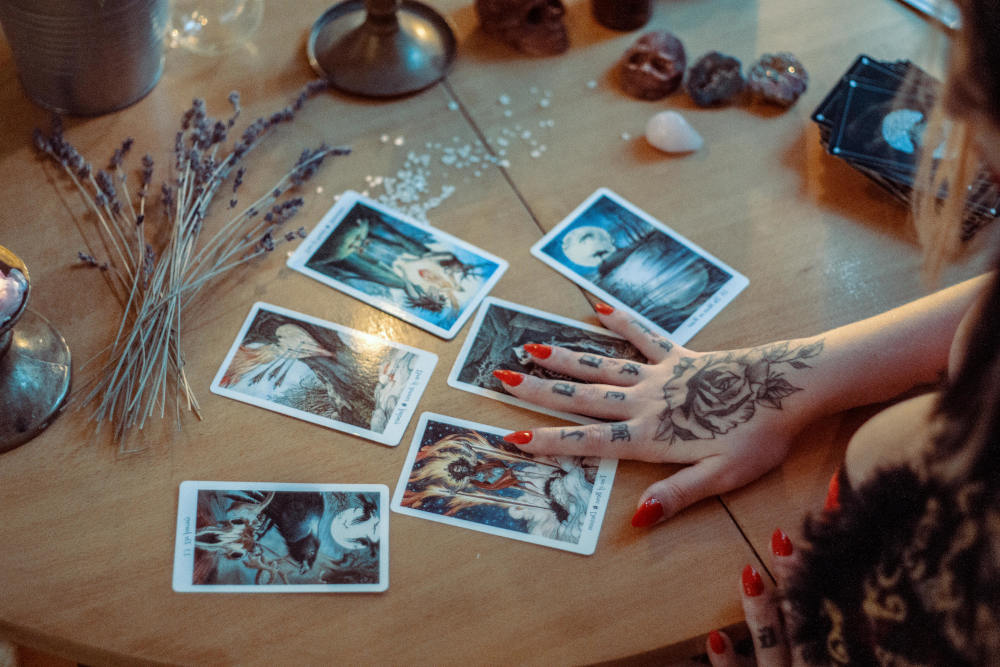
In the realm of divination and self-discovery, Tarot cards and Oracle cards are two of the most popular tools. Though they are often used side by side and can even complement each other, they are not the same. Each has a unique structure, history, and purpose—and understanding these differences can help you choose the right tool for your spiritual or personal development journey.
So, what’s the real difference between tarot and oracle cards? In short:
Tarot cards follow a structured system of symbolism and tradition, while oracle cards are more freeform, intuitive, and customizable.
Let’s explore this in detail, from their origins to their spiritual significance.
Panaprium is independent and reader supported. If you buy something through our link, we may earn a commission. If you can, please support us on a monthly basis. It takes less than a minute to set up, and you will be making a big impact every single month. Thank you!
A Brief History of Tarot and Oracle Cards
Tarot: A Rich, Symbolic Tradition
Tarot originated in 15th-century Europe, first as a card game called “Tarocchi” in Italy. It wasn’t until the 18th century that the tarot began to be used for esoteric and divinatory purposes, particularly within the occult and mystical traditions.
Tarot was influenced by astrology, Kabbalah, alchemy, numerology, and the archetypal theories of philosophers like Carl Jung. The most well-known tarot structure—the Rider-Waite-Smith deck—was published in 1909 and set the foundation for most modern tarot interpretations.
Oracle Cards: A New Age Evolution
Oracle cards are much more recent, becoming popular in the late 20th and early 21st century as part of the New Age movement. Unlike tarot, oracle cards do not have a defined history or structure. Instead, they are created by authors, spiritual teachers, and artists, often designed to convey themes of inspiration, healing, or divine guidance.
Oracle cards are essentially free-form divination tools—they can vary wildly from one deck to another in design, tone, and purpose.
Structure and Components
Tarot Cards: Order and System
A traditional tarot deck contains 78 cards, divided into:
-
22 Major Arcana: Representing major life themes and archetypal energies (e.g., The Fool, The Lovers, Death).
-
56 Minor Arcana: Split into four suits—Cups, Pentacles, Wands, and Swords—with 14 cards each (Ace to King).
Each card in the tarot has specific symbolism and interpretations, often including upright and reversed meanings.
This structure creates a systematic language of symbols. Learning tarot is like learning a symbolic language—you study the meanings of the cards, their relationships, and their positions within a spread.
Oracle Cards: Freedom and Flexibility
Oracle cards can have any number of cards—commonly 36, 44, or 55—and the content depends entirely on the creator. There are no suits, arcana, or universal rules. Decks can be based on:
-
Angels
-
Spirit animals
-
Affirmations
-
Moon cycles
-
Chakras
-
Divine feminine archetypes
-
And more
Each oracle deck typically includes a guidebook written by the creator, offering interpretations and suggestions for use.
The freedom of oracle cards makes them easy to pick up—you don’t need to memorize a system. Each deck is a unique spiritual expression.
Symbolism and Interpretation
Tarot: Archetypes and Deep Symbolism
Every tarot card is rich in multi-layered meaning. The cards are steeped in metaphor, archetype, and myth. Tarot readers often study:
-
Imagery and color symbolism
-
Numerology
-
Astrological correspondences
-
Card combinations in spreads
For example, The Tower might signify sudden upheaval, destruction, or necessary transformation. The 2 of Cups may represent union, connection, or emotional balance.
Tarot’s structured symbolism makes it ideal for deep introspection, psychological exploration, and understanding long-term patterns.
Oracle Cards: Direct and Thematic Messages
Oracle cards are usually simpler in message and more direct. You might draw a card that says “Forgiveness” or “You Are Loved.” The intention is usually uplifting, supportive, or spiritually encouraging.
While oracle cards can include symbolism and metaphor, their interpretations are often straightforward and intuitive, designed to be accessible to readers of all experience levels.
They are excellent for daily inspiration, emotional healing, and spiritual encouragement.
How They’re Used in Readings
Tarot: Structure and Spread-Based Readings
Tarot readings often involve layouts or “spreads”, where card positions influence the meaning. Popular spreads include:
-
The 3-Card Spread (past, present, future)
-
The Celtic Cross
-
Relationship spreads
-
Career path spreads
A tarot reading typically explores the dynamics of a situation, decision-making, personal challenges, or internal conflicts. Because the cards are highly symbolic, interpretation often requires context and intuition.
Tarot readings are great for:
-
Clarity on complex issues
-
Shadow work and self-awareness
-
Uncovering subconscious blocks
-
Tracking growth over time
Oracle Cards: Simplicity and Intuition
Oracle card readings are often more free-form. Many people simply draw one or two cards for daily guidance, spiritual support, or answers to a specific question.
Because the meanings are printed on the cards or described in the guidebook, oracle readings don’t require memorization or complex interpretation.
They’re often used for:
-
Morning routines or rituals
-
Meditation prompts
-
Emotional reassurance
-
Light spiritual check-ins
Spiritual and Philosophical Focus
Tarot: Inner Wisdom and Universal Archetypes
Tarot is often considered a mirror to the psyche. It reflects back internal truths using symbolic language. Many practitioners view tarot as a tool for accessing intuition, inner guidance, or the collective unconscious.
Tarot doesn't predict the future in a fixed sense—it explores potential outcomes based on current energy and choices.
Oracle: Divine Messages and Empowerment
Oracle cards are generally created with the belief that guidance is coming from a higher source—be it angels, spirit guides, ancestors, or the Universe itself. They are often spiritual and affirming, focusing on:
-
Divine timing
-
Emotional healing
-
Personal empowerment
-
Spiritual support
Where tarot digs deep into the structure of your experience, oracle cards offer compassionate support and light.
Comparing Tarot and Oracle Cards Side by Side
| Aspect | Tarot Cards | Oracle Cards |
|---|---|---|
| Number of Cards | Always 78 | Varies (typically 36–55) |
| Structure | Fixed system: Major & Minor Arcana | Free-form, varies by deck creator |
| Symbolism | Rich, complex, rooted in tradition | Simple, direct, modern themes |
| Interpretation | Requires study and context | Intuitive, easy to understand |
| Best Use | In-depth analysis, introspection | Daily guidance, emotional/spiritual support |
| Spiritual Approach | Psychological, archetypal, esoteric | Inspirational, divine, uplifting |
| Learning Curve | Moderate to high | Low |
| Customization | Limited (due to set structure) | Highly customizable |
| Common Tools | Used with spreads and symbolism | Used with affirmations or intentions |
Can You Use Both Together?
Yes! Many spiritual practitioners combine tarot and oracle decks in one reading.
Here’s how a combined reading might look:
-
Start with a tarot spread to uncover deeper patterns or dynamics.
-
Draw an oracle card afterward for a message of guidance, encouragement, or next steps.
This creates a balanced reading: tarot provides clarity and insight, while oracle cards offer emotional and spiritual support.
Using both tools allows you to engage with both the mind and the heart.
Which Should You Choose?
Here’s a guide to help you decide:
-
Choose Tarot if:
-
You enjoy symbolism and psychology
-
You want detailed answers to complex questions
-
You’re ready to commit to study and practice
-
-
Choose Oracle if:
-
You want a gentle, intuitive introduction to card reading
-
You seek daily inspiration and emotional healing
-
You prefer flexible tools that match your spiritual beliefs
-
You can also use both! Many readers find value in having both systems on hand for different moods, questions, or spiritual practices.
Final Thoughts
Tarot and oracle cards are not the same, but they are both powerful tools for personal growth, reflection, and connection to the unseen.
-
Tarot offers a structured, symbolic map of life’s complexities. It’s ideal for those seeking clarity, insight, and transformation.
-
Oracle cards provide a gentler, more intuitive experience. They shine in moments of emotional need, spiritual guidance, and daily reflection.
Both have their place—and their beauty lies in how they help you connect with your inner voice and higher guidance. Whether you choose one or both, the journey begins with a single card and a moment of presence.
Was this article helpful to you? Please tell us what you liked or didn't like in the comments below.
About the Author: Alex Assoune
What We're Up Against
Multinational corporations overproducing cheap products in the poorest countries.
Huge factories with sweatshop-like conditions underpaying workers.
Media conglomerates promoting unethical, unsustainable products.
Bad actors encouraging overconsumption through oblivious behavior.
- - - -
Thankfully, we've got our supporters, including you.
Panaprium is funded by readers like you who want to join us in our mission to make the world entirely sustainable.
If you can, please support us on a monthly basis. It takes less than a minute to set up, and you will be making a big impact every single month. Thank you.































0 comments